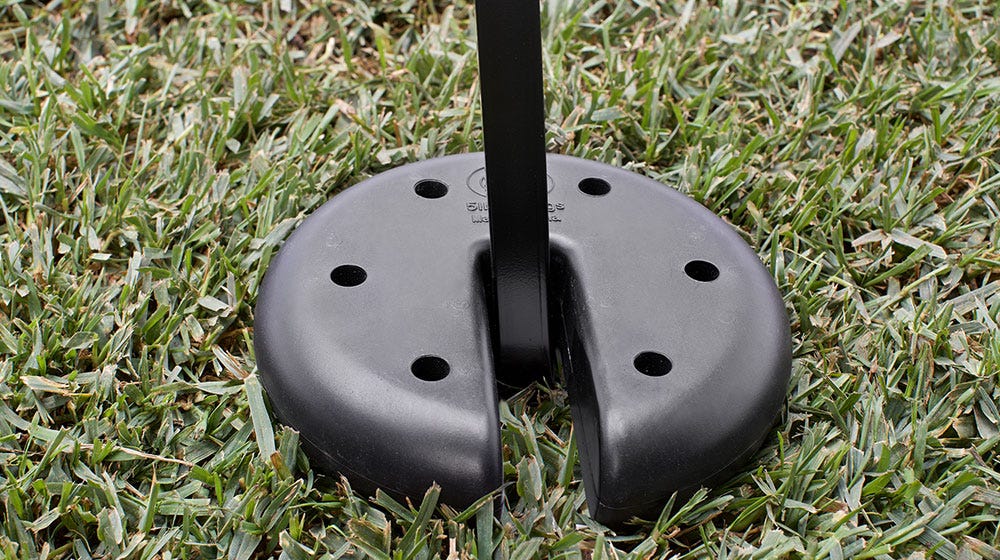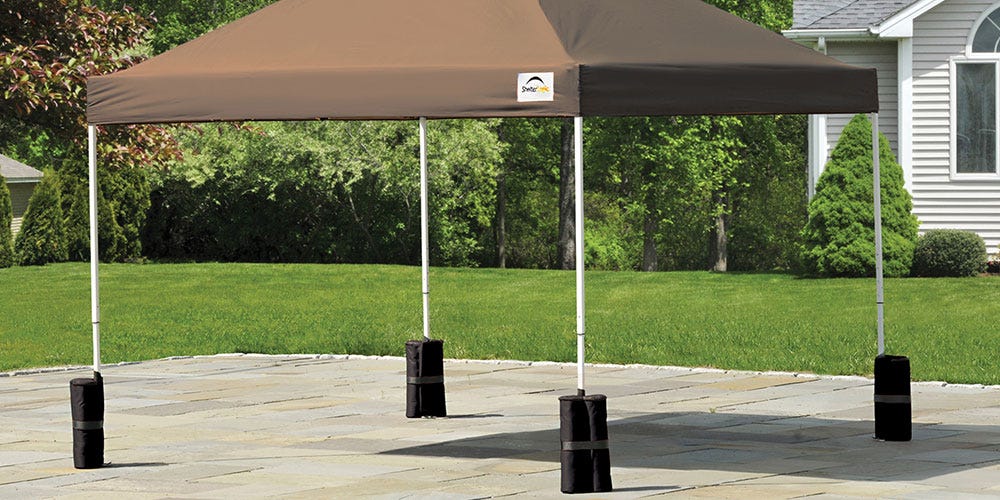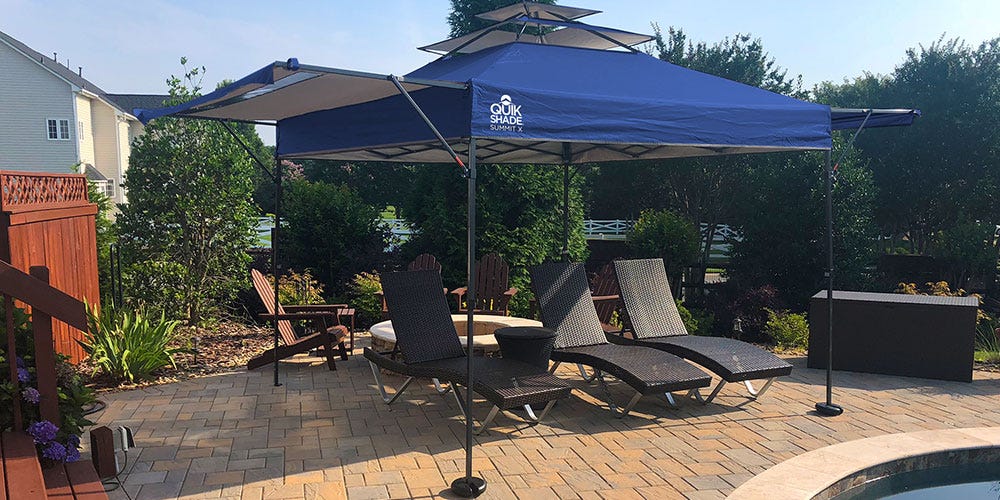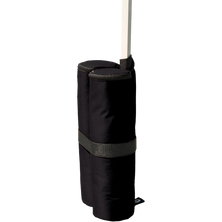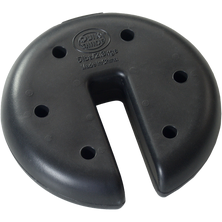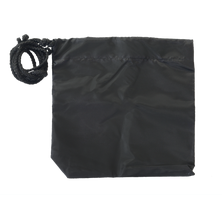Pop-up canopy tents are incredibly convenient to own, and they work for almost any occasion, from sporting events and family reunions to vendor fairs and casual backyard barbecues. While they're a fantastic item to have handy, you're likely headed for disaster if you use them without anchors.
What Is a Pop-Up Canopy Tent?
A pop-up canopy tent sometimes referred to as a portable gazebo or a frame tent, is essentially a canopy tent that folds down for easy portability. Most pop-up canopy tents come in two pieces, but many modern pop-ups often have a foldable metal frame pre-attached to a canopy.
Pop-up canopies are perfect for adding a bit of extra shade and protection from the elements or providing food coverage if you're eating outside or hosting an outdoor event. The frame of a pop-up canopy is often steel or aluminum, with the steel being the heavier and more expensive of the two. Most canopy tops are made of polyester or a blend thereof.
Pop-up canopies are open-sided, distinguishing them from tent products like a semi-permanent shelter. You'll often find pop-up canopies at trade shows or concerts covering the merchandise or food tents. Pop-up canopies are great for the beach, and they can go pretty much anywhere you go, as long as you have a place to store and a way to transport them!
Why Do You Need to Secure a Pop-Up Canopy?
Securing your pop-up canopy is the primary responsibility that comes with owning one. Chances are you'll use your canopy around others, whether it be your family in your backyard or those attending the same public beach, campground, or event. Even the slightest gust of wind can take an unsecured pop-up canopy tent airborne, which is incredibly dangerous for everyone in its path.
You're welcome to erect a pop-up canopy tent in many public places, but those places will require you to ensure they're secured to prevent an accident. While there might not be a team dedicated to checking the anchors on pop-up canopies set up at public events, you can bet you'll be in a world of trouble when your canopy unexpectedly takes flight, and it doesn't take much.
Prevent Property Damage
In addition to the possibility of someone facing injury due to an airborne canopy pop-up tent, it's plausible to assume that property damage (at least to an extent) will come with an unsecured canopy tent that blows away. Building windows and cars can easily fall victim to a rogue canopy tent.
If you're set up at a farmers market or vendor fair, you could potentially cause a ton of damage to the goods and booths of other vendors, racking up a large sum in owed money. Property damage almost always results from an unsecured canopy pop-up, and they can even be deadly in extreme weather.
Where Would I Use a Pop-Up Canopy
There are plenty of places where a pop-up canopy makes complete sense. In fact, most people don't realize how much they'll use one until they purchase it, especially during the warmer months. You can use pop-up canopies right in the comfort of your own backyard if you don't spend much time at public events.
Cookouts, baby showers, birthday parties and various family events become much more comfortable with additional shade and covered food. However, it's common for consumers to purchase a pop-up canopy tent because they intend to use it in a public setting.
Street fairs, vendor events, beach days, tailgating at sporting events, farmers' markets, camping, and picnics at the park are only a few events that call for a pop-up canopy tent. Concerts are a great place to utilize a pop-up canopy; as you've probably already noticed, these are all very public places. It's crucial to secure a pop-up canopy tent anytime, particularly in public spaces with a dense crowd.
Prevent Risk of Injury
Securing your tent dramatically reduces the potential risk for injury when it's in use. Canopy tents are not small structures, most measuring ten by ten feet. If taken by a gust of wind, a canopy tent can do quite a bit of damage to surrounding humans and structures.
Remember, the frame of a canopy ranges from aluminum to stainless steel to steel. Though convenient and easy to transport, they can be heavy, especially when gaining traction. Can you imagine a steel canopy tent blowing up into the air and a crowd of people? There would undoubtedly be injuries and possible deaths.
How Do I Keep a Pop-Up Canopy Secured?
Securing your pop-up canopy is the best way to enjoy it without creating a potential hazard and allowing you to relax knowing that your canopy will stay put. Luckily, there are quite a few options when it comes to securing your pop-up canopy tent, and none of them are difficult to manage. You'll find that it's as easy to secure your tent as it is to set it up, and you can try the following methods.
Stakes and Stabilizing Lines
Stakes and stabilizing lines, also known as "guy lines," are very common in the world of pop-up canopy security. You can likely find a canopy tent for sale with stakes and stabilizing lines, or at least one of the two. It's uncommon for a pop-up canopy tent to come without the necessary stakes to hold it in place unless you're purchasing a used tent.
If you have to purchase stakes separately, look for something durable, preferably made of steel with a hooked head so you can push them into the ground and secure rope or stabilizing lines to them tightly. Stabilizing lines might also come with the tent you purchase but can be found easily at any hardware or home improvement store.
If the stakes come with the tent, ensure that you follow the manufacturer's instructions carefully. It's a crucial part of securing your tent correctly. If you're unsure of the instructions or they're unclear, you can contact the manufacturer or find a plethora of information on reputable social and YouTube channels. Overall, stakes and stabilizing lines are the most common method of keeping a pop-up canopy.
Canopy Weight Plates
Canopy weight plates are a super simple and effective method for weighing down your pop-up tent. Canopy weight plates are specifically made to fit around the leg of your canopy, adding weight so it can't go anywhere while it's in use. Weight plates can come in a few different varieties, including circle and square, typically five pounds each and made of heavy cement.
If you spend a lot of time tailgating or attending farmers' markets or vendor fairs in parking lots or paved areas, weight plates will likely work well for you. While stakes and stabilizing lines need suitable terrain (like a sandy beach or soft grass) to push into the ground to anchor the canopy, canopy weight plates allow you to use your tent on any terrain.
Canopy Anchor Bags
Canopy anchor bags work well on hard and soft surfaces, offering a portable, temporary anchoring solution for pop-up canopy tents. Canopy anchor bags wrap around each tent leg, and you'll secure them with velcro. You'll use your filler of choice to fill them up and weigh down your tent.
Most people choose sand to fill their canopy anchor bags, but other options exist, such as manufactured rocks or pebbles. You can find more than one option at your local home improvement store or online. The manufacturer from which you purchased your tent will likely be able to tell you the fill they recommend and what will work best for your tent, considering the locations where you typically set it up.
Canopy Weight Bags
Canopy weight bags are similar to canopy weight bags. They secure to the leg of the tent, and you can fill them with sand or gravel or the filling of your choice, and they'll keep your tent weighed down for as long as it's erected. Some canopy weight bag companies sell inserts made specifically for the weight bags, making it possible for you to weigh down your canopy without having to deal with fill.
There are canopy weight bags that come pre-filled, which makes it easy for you to unload them and set them up. Once they're filled, you can leave them that way, so if the filling process keeps you from using empty canopy weight bags, you should know that there's no need to empty them after every use unless you cannot transport them while filled.
As you can see, plenty of viable options are available on the market to keep your canopy tent secure. Regardless of your choice, ensure the weight is at least five pounds and is secured tightly to the tent to avoid accidents.
Can I Create My Own Pop-Up Canopy Anchors?
While we recommend using one of the four options we've mentioned above, there are other options you can explore if you find yourself in a pinch. Perhaps you forgot to pack the anchors, and there isn't anyone available to bring them to you, or something goes wrong with your anchor choice during tent set-up.
In that case, you'll need to know how to secure your canopy tent without causing a potential human injury or property damage if it blows over. Whatever you do, do not set up your canopy tent and leave it unsecured. If you don't have an option to keep it in one place, then it's best not to set it up.
Bucket of Sand
Instead of stakes, you can use a five-gallon bucket filled with sand. This clever option is suitable for any surface and will keep your canopy in place. You might not have access to a five-gallon bucket and sand if something goes wrong with your stakes, so it's essential to plan out your alternative option.
Bungee Cords
If you don't have any stabilizer or guy lines handy to attach to your stakes, you can always use bungee cords! You can find bungee cords almost anywhere. Every establishment, from major retailers to gas stations and convenience stores, has bungee cords in stock. You may have to purchase more than one to get the length you require, but they'll do the job almost as well as a stabilizer line.
If you're not close to a store, try asking people around you for a bungee cord. These are everyday items that people keep in their cars in case of an emergency, and you can likely find some to borrow. Still, you must ensure that every leg of your canopy is secure.
Fence
If you're entirely out of other options, you can secure a pop-up canopy tent to a nearby fence. However, you must ensure that the fence is stable and sturdy. Do not secure your canopy to a fence that has weaknesses or appears rickety or poorly maintained.
You can use rope or bungee cords to keep your pop-up canopy attached to a fence. However, if you have a way to weigh the legs down as well, it's a good idea to take advantage of both methods.
If you have to use one of these alternative methods to secure your pop-up tent, ensure you do so with care. Take the time to focus on the placement and strength of the weights or bungee cords, and check on them routinely through the day, just as you would with traditional methods.
Finding the Perfect Pop-Up Canopy Tent
Quik Shade has the perfect selection of pop-up canopy tents for any event. Not only can we help you find the right canopy tent for your needs, but we also have the accessories to help you keep them secure while they're in use. We know how important it is for our customers to enjoy their time outdoors safely, and we'll provide you with the tools to give you peace of mind when utilizing your pop-up canopy tent.
If you have any questions regarding our extensive selection of pop-up canopy tents and anchors, contact our team today!

